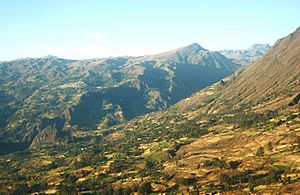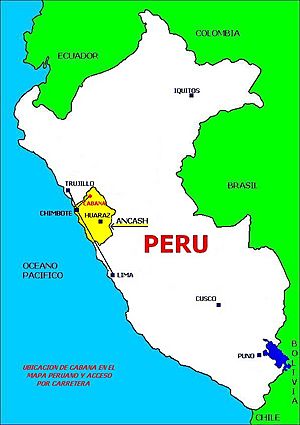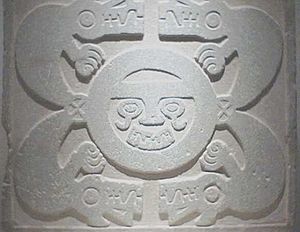Cabana, Peru facts for kids
Quick facts for kids
Cabana
Qawana
|
|
|---|---|
|
City
|
|

Cabana as seen from Tauca District
|
|

Location of Cabana in the Pallasca province
|
|
| Country | |
| Region | Ancash |
| Province | Pallasca |
| District | Cabana |
| Founded | January 2, 1857 |
| Area | |
| • Total | 150.29 km2 (58.03 sq mi) |
| Elevation | 3,224 m (10,577 ft) |
| Population
(2005 census)
|
|
| • Total | 2,918 |
| • Density | 19.416/km2 (50.287/sq mi) |
| Time zone | UTC-5 (PET) |
| UBIGEO | 021501 |
Cabana is a city located in the beautiful country of Peru. It's a very important place because it's the main city (or capital) for both the Cabana District and the Pallasca Province. These are parts of the Ancash Region in northern Peru.
Cabana was officially founded on January 2, 1857. But people lived there long before that, even before the Spanish explorers arrived!
The city of Cabana is divided into four main areas, like different neighborhoods:
- Huayumaca
- Pacchamaca
- San Jerónimo
- Trujillo
Did you know that Alejandro Toledo, a former President of Peru, was born in Cabana?
Contents
Discover Cabana's Past
Cabana has a long and interesting history. It was first founded in 1711. Back then, it was called "Caguana." This name came from the old Cully Language, which was spoken in this area. "Caguana" meant "to repair" or "to think deeply."
When the Spanish explorers came, they found it hard to say "Caguana." So, they started calling it "Cabana" instead. That's how the city got its current name!
Cabana became an official part of Peru on February 12, 1821. It was first a small part of a much larger area called Conchucos. Later, on December 2, 1856, Cabana became its own "district." This happened when Don Ramón Castilla was President.
In 1861, the big Conchucos province was split into two new provinces: Pallasca and Pomabamba. Cabana was part of Pallasca.
Cabana grew in importance over time. On October 30, 1901, a law made Cabana the capital of the Pallasca province. It was also given the special title of "Villa." Then, on November 18, 1914, Cabana became a "City" by law.
Finally, on January 26, 1943, the Pallasca province was divided again. It became two provinces: Pallasca (with Cabana as its capital) and Corongo. This setup is still how things are today.
Cabana is one of 11 districts in the Pallasca province. It shares borders with Bolognesi and Huandoval districts to the north. To the east and south, it borders the Corongo province. To the west, it borders the Tauca district.
Cabana's Weather
| Climate data for Cabana, elevation 2,985 m (9,793 ft), (1991–2020) | |||||||||||||
|---|---|---|---|---|---|---|---|---|---|---|---|---|---|
| Month | Jan | Feb | Mar | Apr | May | Jun | Jul | Aug | Sep | Oct | Nov | Dec | Year |
| Mean daily maximum °C (°F) | 14.8 (58.6) |
14.3 (57.7) |
13.8 (56.8) |
14.7 (58.5) |
16.0 (60.8) |
16.7 (62.1) |
16.8 (62.2) |
17.1 (62.8) |
16.8 (62.2) |
15.7 (60.3) |
15.6 (60.1) |
14.8 (58.6) |
15.6 (60.1) |
| Mean daily minimum °C (°F) | 7.5 (45.5) |
7.6 (45.7) |
7.6 (45.7) |
7.6 (45.7) |
7.2 (45.0) |
6.6 (43.9) |
6.5 (43.7) |
6.6 (43.9) |
7.0 (44.6) |
7.2 (45.0) |
7.2 (45.0) |
7.2 (45.0) |
7.2 (44.9) |
| Average precipitation mm (inches) | 117.5 (4.63) |
129.6 (5.10) |
196.7 (7.74) |
101.7 (4.00) |
29.4 (1.16) |
6.0 (0.24) |
4.3 (0.17) |
3.7 (0.15) |
18.8 (0.74) |
61.2 (2.41) |
57.7 (2.27) |
105.4 (4.15) |
832 (32.76) |
| Source: National Meteorology and Hydrology Service of Peru | |||||||||||||
Fun Traditions and Festivities
Cabana is a place rich in culture and celebrations!
Easter Celebrations
Easter in Cabana is a big event, much like the famous celebrations in Ayacucho, Peru. The festivities last for a whole week!
- It starts on Palm Sunday. People remember Jesus's entry into Jerusalem on a donkey.
- On Holy Wednesday, statues of Jesus and Mary are carried in a procession. This remembers their meeting.
- Holy Thursday involves a special Mass. The priest washes the feet of church members. Then, a statue of Jesus on the cross is carried in a procession.
- Good Friday at 3 PM is a time to remember Jesus's death. Later that night, an image of Jesus in a coffin is carried through the streets.
- On Holy Saturday, an image of Jesus alive is taken out in a procession.
Santiago Apostle Festivities
The celebrations for Santiago Apostle are probably the most important in Cabana. They last for two weeks every July! They start on July 16 and end on July 25, which is the main day.
During these two weeks, hundreds of people visit Cabana from all over the world. They come to enjoy the delicious food, lively dances, and everything Cabana offers. People in Cabana barely rest during this time! Music plays all day and often until early morning. Visitors can often find free food and drinks.
While people dance for two weeks, July 24 and 25 are special. On these days, people attend Mass and join a procession. The statue of Santiago Apostle is carried through the streets of Cabana. This festival is also celebrated by people from Cabana in other cities like Chimbote, Lima, and even in the United States.
Amazing Dances of Cabana
Dances in Cabana tell stories of the past. They show the beliefs and dreams of the people. These dances keep ancient traditions alive. Cabana honors its patron saint, Santiago Apostle, with colorful dances. Some of the most famous are The Mojiganga, The Blanquillos, and The Kiyayas. Each dance has its own steps, costumes, songs, music, and meaning.
The Mojiganga
The word "Mojiganga" means "funny" or "joking." This dance was brought by the Spanish. It shows different kinds of people in society. You can see The Mojiganga during the Santiago Apostle festivities in July.
- In the mornings, dancers run through the main streets. They invite everyone to the "paseo de res" (parade of the cow). A cow will be given to one of the festival organizers later.
- In the afternoon, the cow is delivered. Dancers perform to the sound of special music.
The characters in The Mojiganga include:
- The Patron and Patrona: These represent wealthy people. They wear fancy clothes. The man wears a suit, hat, and cane. The woman wears a dress, veil, purse, and high heels.
- The Shepherd and Shepherdess: They represent people from the countryside. The shepherdess wears an embroidered skirt, blouse, sandals, and a straw hat. The shepherd wears trousers, a shirt, a wool poncho, a bag, a straw hat, and carries a whip.
- The Vilches: This character is in between the rich and the rural. They show power over the cattle. The Vilches wears a richly embroidered dress with gold or silver thread. They have a crown of feathers and mirrors. On their back, they carry a special cloth. They also have a decorative ribbon around their neck and a decorated chest piece.
All the dancers wear special masks.
The Blanquillos
The Blanquillos were groups of warriors. They fought against Spanish rule, similar to other groups like the "Huanca" and "shacshas." The Blanquillo dancers traveled through many parts of the Conchucos Culture area, where the Spanish were.
These warriors were made up of people from the Pasha town, Spanish, and mixed-race people. They used to fight in the main square in the mornings. This dance shows the power struggles of those times. Back then, the "Pashas" spoke the "Cully" language and worshipped a god named "Catequilla."
You can see The Blanquillo dance on July 24 and 25 each year. The dancers move through the city's main streets. They accompany the procession of Santiago Apostle.
A group of 10 to 12 people performs this dance. They all wear elegant corduroy costumes with gold thread decorations, in a Spanish style. They wear face masks, feather crowns, and colorful scarves.
During their dance, the Blanquillo dancers have a unique style. They place their scarf on someone's shoulder in the audience. That person can then give them money, candy, or soda as a reward.
The Kiyayas
"Kiyayas" is a Cully word meaning "consecrated women." These women were chosen to worship the "God Catequilla" and other gods, like the sun, moon, lightning, and rainbow. They were always close to the priests and leaders of the Pashas.
The Spanish tried to stop these practices with their laws. But the KIYAYAS survived as a dance!
Like the "Blanquillo," the "Kiyayas" dance during the Santiago Apostle festivities in July. They wear black skirts with a side opening. These skirts are decorated with gold threads and patterns. Underneath, they wear white skirts with special fabrics and designs from the Pasha culture. They also wear a white blouse with wide, puffy sleeves. On their heads, they wear a crown of showy flowers and a white tulle veil. They usually wear light leather shoes and silver jewelry.
Toro de Trapo (Rag Bull)
This dance honors the Virgin of Llactabamba. Dancers accompany the "mamita" (a loving term for the Virgin) as she goes up to Cabana and returns to her temple every November. The "rag bull" is a wooden frame covered with white cloth. A black scarf is on its back. A skilled volunteer carries it and dances joyfully around the Virgin's statue.
Explore Cabana's Ancient Sites
The Cabana District has many old archaeological sites. The most impressive is the Strength of the Pashash. This might have been a central defense spot and a religious place for the Conchucos Region. History says it was the home of the idol Katequilla, a god of the Conchucos and Huamachucos people. You can also find the Ruins of Mashgonga here.
People of Cabana (Cabanistas)
Many people from Cabana, called "cabanistas," live in Lima, the capital of Peru. They have their own organizations, like the Cabanista Association. There are also other groups that bring people from Cabana together, such as the Sport Club Cabana Not 1 and the brotherhood 25 de Julio. The Cultural Project Cantarria is another recent group. You can also find Cabanista organizations in Chimbote and the United States.
Archaeological Discoveries
Near Cabana, you'll find the archaeological site of Pashash. This site gave its name to the Pashash culture (500-1000 AD). Many ancient objects from this culture have been found in the area.
The Pashash culture is seen as a later development of the Recuay culture. It grew in the northern mountain area of the Ancash region. You can also find remains of this culture in Chacas, a town in east-central Ancash, and other places.
See also
 In Spanish: Cabana (Pallasca) para niños
In Spanish: Cabana (Pallasca) para niños


